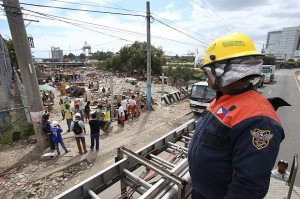
A policeman stands guard to foil any attempt by informal settlers to retake their home lots neart the Mahiga Creek, an area declared a danger zone because of the risk of flooding. (CDN PHOTO/ JUNJIE MENDOZA)
A “green corridor” will replace the colony of informal settlers in the Mandaue City side of the Mahiga Creek, according to a plan of the Mandaue city government.
After the demolition of houses of 4,000 settlers on the bank of the Mahiga Creek, roads will be constructed and trees will be planted there.
“All major waterways of Mandaue, starting with Mahiga Creek will soon be a green corridor,” said Architect Florentino Nimor Jr. of the City Planning and Development Office (CPDO).
The plan also calls for a nature park with a playground for children and families.
Green corridors in Singapore, India, and European countries enable traffic to flow smoothly in a more “environmentally acceptable, climate-smart manner.”
“After the dredging, we will develop the area vacated by our informal settlers. Roads will be constructed and some parts of it will be planted with trees,” said Nimor.
For this to push through, the CPDO is pushing this year for the revision of Mandaue’s Comprehensive Land Use Plan.
“Included in our proposed revision is the zoning ordinance and the conversion of all our major waterways to a green corridor,” Nimor said during a recent intercity Drainage Summit.
The summit was organized by the Cebu City government and attended by local officials of the cities of Mandaue and Talisay, including Mayors Jonas Cortes, Michael Rama and Johnny de los Reyes.
The Department of Public Works and Highways (DPWH), Japan International Cooperative Agency (JICA) and members of the Mega Cebu movement were also present.
Mandaue city started clearing sitios Mahayag and Mahusay of barangay Subangdaku in forced demolitions. Sitios Marna and Sapa-Sapa I and II will follow.
Next week, the DPWH will start dredging the Mahiga Creek.